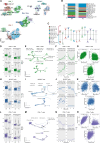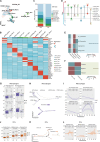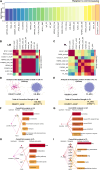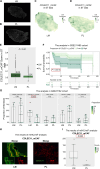Comprehensive single-cell atlas of colorectal neuroendocrine tumors with liver metastases: unraveling tumor microenvironment heterogeneity between primary lesions and metastases
- PMID: 39838423
- PMCID: PMC11748842
- DOI: 10.1186/s12943-025-02231-y
Comprehensive single-cell atlas of colorectal neuroendocrine tumors with liver metastases: unraveling tumor microenvironment heterogeneity between primary lesions and metastases
Abstract
Background: Colorectal neuroendocrine tumors with liver metastases (CRNELM) are associated with a poorer prognosis compared to their nonmetastatic counterparts. A comprehensive understanding of the tumor microenvironment (TME) heterogeneity between primary lesions (PL) and liver metastases (LM) could provide crucial insights for enhancing clinical management strategies for these patients.
Methods: We utilized single-cell RNA sequencing to analyze fresh tissue samples from CRNELM patients, aiming to elucidate the variations in TME between PL and LM. Complementary multidimensional validation was achieved through spatial transcriptomics, bulk RNA sequencing, and multiplex immunohistochemistry/immunofluorescence.
Results: Our single-cell RNA sequencing analysis revealed that LM harboured a higher proportion of CD8 + T cells, CD4 + T cells, NK cells, NKT cells, and B cells exhibiting a stress-like phenotype compared to PL. RGS5 + pericytes may play a role in the stress-like phenotype observed in immune cells within LM. MCs in PL (PL_MCs) and LM (LM_MCs) exhibit distinct activation of tumor-associated signaling pathways. Notably, COLEC11 + matrix cancer-associated fibroblasts (COLEC11_mCAFs) were found to be significantly associated with LM_MCs. Cell communication analysis unveiled potential targetable receptor-ligand interactions between COLEC11_mCAFs and LM_MCs. Multidimensional validation confirmed the prominence of the characteristic stress-like phenotypes, including HSPA6_CD8_Tstr, HSPA6_NK, and COLEC11_mCAFs in LM. Moreover, a higher abundance of COLEC11_mCAFs correlated with poorer survival rates in the neuroendocrine tumor patient cohort.
Conclusion: Overall, our study provides the first single-cell analysis of the cellular and molecular differences between PL and LM in CRNELM patients. We identified distinct cell subsets and receptor-ligand interactions that may drive TME discrepancies and support metastatic tumor growth. These insights highlight potential therapeutic targets and inform strategies for better managing CRNELM patients.
Keywords: Colorectal neuroendocrine tumour; Heterogeneity; Liver metastases; Single-cell RNA sequence; Spatial transcriptomics; Tumour microenvironment.
© 2025. The Author(s).
Conflict of interest statement
Declarations. Ethics approval and consent to participate: The study was approved by the Institutional Review Board of the Cancer Hospital, Chinese Academy of Medical Sciences (ID: NCC2021C-515), and informed consent was obtained from all the patients. The patients/participants provided written informed consent to participate in this study. The authors are accountable for all aspects of the work and for ensuring that questions related to the accuracy or integrity of any part of the work are appropriately investigated and resolved. Consent for publication: Not applicable. Competing interests: The authors declare no competing interests.
Figures








Similar articles
-
Diversity and intratumoral heterogeneity in human gallbladder cancer progression revealed by single-cell RNA sequencing.Clin Transl Med. 2021 Jun;11(6):e462. doi: 10.1002/ctm2.462. Clin Transl Med. 2021. PMID: 34185421 Free PMC article.
-
Single-cell RNA sequencing and spatial transcriptomics reveal the heterogeneity and intercellular communication of cancer-associated fibroblasts in gastric cancer.J Transl Med. 2025 Mar 18;23(1):344. doi: 10.1186/s12967-025-06376-8. J Transl Med. 2025. PMID: 40102930 Free PMC article.
-
Immune suppressive microenvironment in liver metastases contributes to organ-specific response of immunotherapy in advanced non-small cell lung cancer.J Immunother Cancer. 2023 Jul;11(7):e007218. doi: 10.1136/jitc-2023-007218. J Immunother Cancer. 2023. PMID: 37463790 Free PMC article.
-
Application of Spatial Transcriptomics in Digestive System Tumors.Biomolecules. 2024 Dec 27;15(1):21. doi: 10.3390/biom15010021. Biomolecules. 2024. PMID: 39858416 Free PMC article. Review.
-
Identification of non-cancer cells from cancer transcriptomic data.Biochim Biophys Acta Gene Regul Mech. 2020 Jun;1863(6):194445. doi: 10.1016/j.bbagrm.2019.194445. Epub 2019 Oct 22. Biochim Biophys Acta Gene Regul Mech. 2020. PMID: 31654804 Free PMC article. Review.
References
-
- Yao JC, Hassan M, Phan A, et al. One hundred years after “carcinoid”: epidemiology of and prognostic factors for neuroendocrine tumors in 35,825 cases in the United States. J Clin Oncol. 2008;26(18):3063–72. - PubMed
-
- Sahani DV, Bonaffini PA, Fernández-Del Castillo C, et al. Gastroenteropancreatic neuroendocrine tumors: role of imaging in diagnosis and management. Radiology. 2013;266(1):38–61. - PubMed
-
- Bagante F, Spolverato G, Merath K, et al. Neuroendocrine liver metastasis: The chance to be cured after liver surgery. J Surg Oncol. 2017;115(6):687–95. - PubMed
-
- Riihimäki M, Hemminki A, Sundquist K, et al. The epidemiology of metastases in neuroendocrine tumors. Int J Cancer. 2016;139(12):2679–86. - PubMed
-
- Pavel M, Grossman A, Arnold R, et al. ENETsS consensus guidelines for the management of brain, cardiac and ovarian metastases from neuroendocrine tumors. Neuroendocrinology. 2010;91(4):326–32. - PubMed
MeSH terms
Substances
Grants and funding
- 2023YFC3403800, 2023YFC3403804/National Key Research and Development Program of China
- 82141127/National Natural Science Foundation of China
- 2021-I2M-C&T-B-057/CAMS Innovation Fund for Medical Sciences (CIFMS)
- 2019PT310026/Non-Profit Central Research Institution Fund of the Chinese Academy of Medical Sciences
- SZSM202011010/Sanming Project of Medicine in Shenzhen
LinkOut - more resources
Full Text Sources
Medical
Research Materials
Miscellaneous

